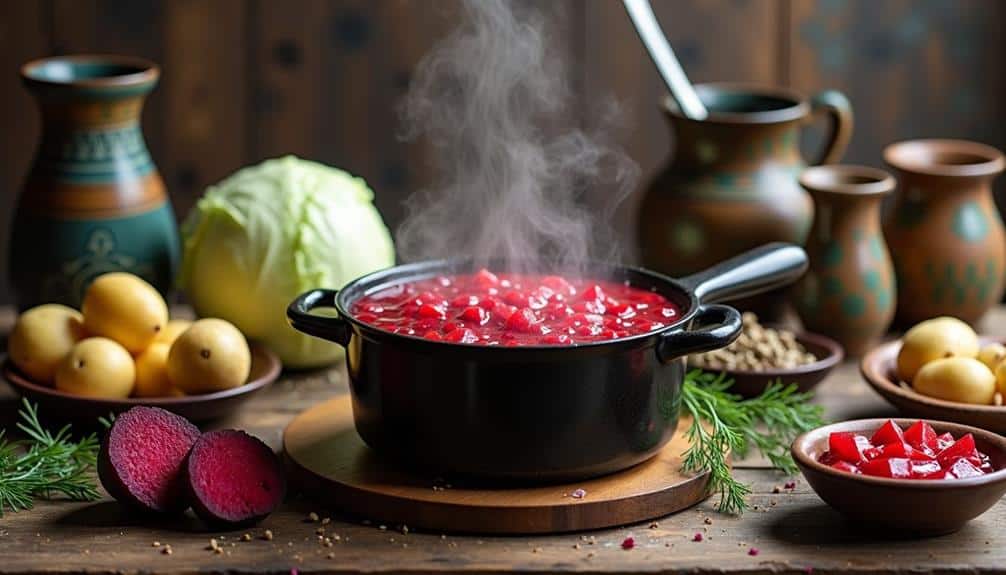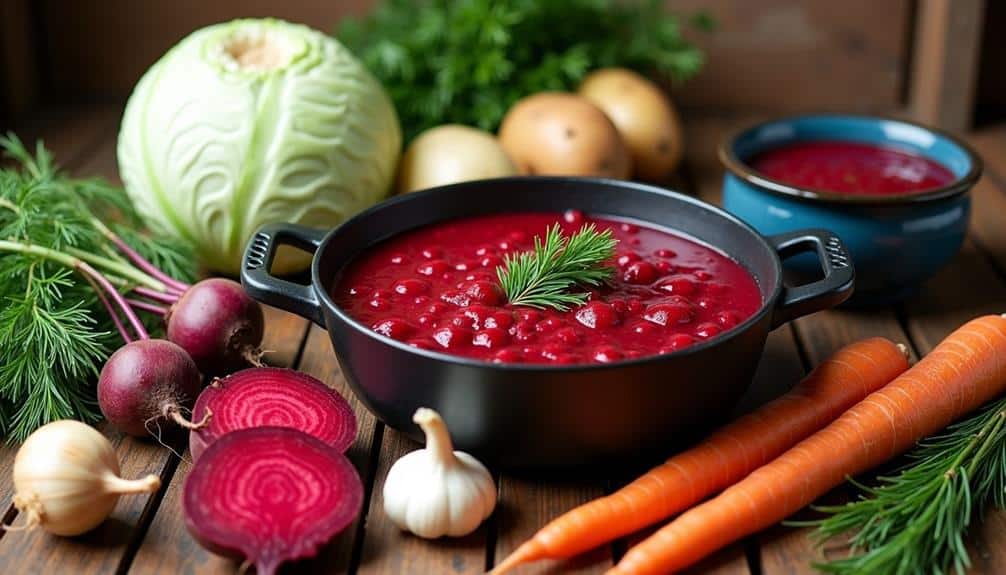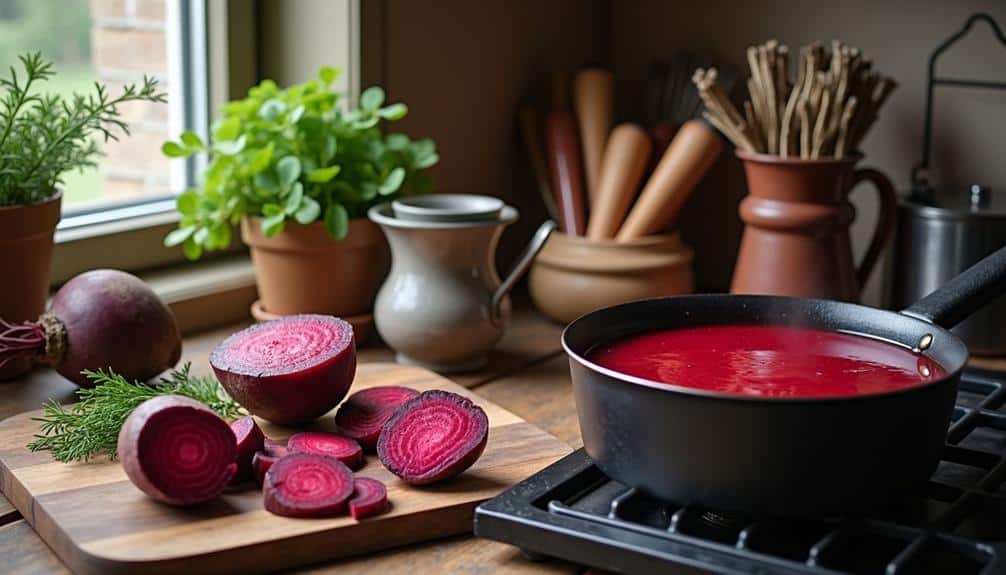When you think of Russian cuisine, borscht likely comes to mind—a beetroot soup that’s both hearty and rich in cultural significance. Imagine the warmth of a bowl filled with vibrant red beets, aromatic onions, and tender potatoes, each spoonful a taste of history. You might be surprised to learn that borscht has numerous regional variations, each adding its own twist. If you’re curious about the origins of this iconic dish and eager to try a classic recipe that brings Russian traditions to your kitchen, you’re in for a culinary journey that promises to be both enlightening and delicious.
Origins of Borscht

Often regarded as the heart and soul of Eastern European cuisine, borscht has a rich and complex history that traces back to the diverse cultural tapestry of the region. You can trace its roots to ancient times when nomadic tribes roamed the vast steppes, laying the groundwork for a dish that would become a culinary symbol of resilience and resourcefulness.
The historical influences on borscht are as varied as the lands and peoples it has traversed, from the hearty Slavic peasantry to the sophisticated kitchens of Russian nobility.
The cultural significance of borscht in Eastern Europe can’t be overstated. It’s more than just a soup; it’s a symbol of hospitality and a staple at family gatherings and festive occasions.
Imagine a bowl of borscht, its vibrant red hue representing not just the beets, but also the warmth and unity of a shared meal. Through centuries of hardship and celebration, borscht has remained a culinary constant, offering comfort and continuity.
Variations of Borscht
While borscht is widely recognized for its classic beet-based rendition, the soup actually boasts a myriad of variations that reflect the diverse cultures and traditions of Eastern Europe. Each regional borscht variation highlights unique ingredients and preparation methods, showcasing the soup’s adaptability and deep cultural borscht significance.
In Ukraine, you’ll find green borscht, made with sorrel and often served in the spring. Polish borscht, known as barszcz, is typically clearer and may be served with small dumplings called uszka.
Lithuanian cold borscht, or šaltibarščiai, is a refreshing summer version mixed with kefir, cucumbers, and hard-boiled eggs, offering a delightful contrast to the hearty, hot versions.
In Russia, there’s a variant called “moskovsky borscht,” which includes sausages and beef, adding richness and depth to the flavor. Belarus has its own twist with a meatier version, sometimes incorporating pork, potatoes, and cabbage.
Each variation of borscht isn’t just a recipe but a reflection of the region’s history and lifestyle. By exploring these regional borscht variations, you’re not just tasting a dish; you’re experiencing the cultural borscht significance that has been passed down through generations, making each bowl a culinary journey.
Key Ingredients

To truly appreciate the depth and flavor of borscht, it’s essential to understand its key ingredients. The heart of this vibrant soup is the beetroot, which gives borscht its characteristic deep red color. Beetroots are rich in antioxidants and vitamins, offering numerous health benefits like improved blood flow and reduced inflammation.
Next, you’ll find cabbage, which brings a delightful crunch and is packed with fiber and vitamin C. Carrots and potatoes add natural sweetness and heartiness, making the soup more filling and nutritious. Onions and garlic provide a robust base, enhancing the overall flavor profile with their aromatic qualities.
Typically, borscht also includes a meat component, often beef or pork, which infuses the broth with a rich, savory taste. For a vegetarian twist, some versions skip the meat and rely on vegetable broth. Fresh dill and a dollop of sour cream are traditional garnishes, adding a fresh, creamy finish.
These ingredients aren’t just about taste; they hold deep cultural significance, reflecting the agricultural staples of Eastern Europe. Understanding these elements helps you appreciate borscht not only as a dish but as a nourishing link to Russian heritage and tradition.
Popular Russian Dishes
Russian cuisine is a treasure trove of hearty and flavorful dishes that reflect the country’s rich history and diverse geography. You’ll find that each meal is steeped in cultural significance, often tied to traditional feasts and celebrations.
One of the most iconic dishes is Borscht, a beetroot soup that’s a staple in many Russian homes. It’s not just about the beets; the soup also features seasonal ingredients like cabbage, carrots, and potatoes, making it a versatile choice throughout the year.
Another popular dish is Pelmeni, delightful dumplings filled with meat, often enjoyed during cold winter months. These dumplings are a regional specialty from Siberia, showcasing the area’s culinary history.
Then, there’s Beef Stroganoff, a rich and creamy dish that has become a favorite far beyond Russia’s borders.
Don’t forget Blini, thin pancakes that can be either savory or sweet, frequently served during Maslenitsa, a traditional feast celebrating the end of winter.
Each dish you encounter tells a story of Russia’s regional specialties and the seasonal ingredients that have shaped its culinary traditions. Embrace the flavors and history that make Russian cuisine so unique and unforgettable.
Cooking Techniques

Each of these beloved Russian dishes owes its unique taste and texture to traditional cooking techniques that have been perfected over generations.
You’ll find that mastering these methods is essential to capturing the authentic flavors of Russian cuisine. One key technique is sautéing vegetables. This process involves cooking onions, carrots, and other root vegetables in a bit of oil or butter until they’re soft and caramelized.
Sautéing not only deepens the flavor but also forms the aromatic base for many dishes, including the iconic borscht.
Next, let’s talk about simmering broth. This technique is crucial for developing rich, nuanced flavors.
To achieve this, you’ll gently cook your broth over low heat for an extended period. This slow process allows the ingredients to meld together, creating a harmonious and robust flavor profile.
Whether you’re making a hearty meat broth or a delicate vegetable stock, patience is key.
Borscht Recipe
Why not dive into the heart of Russian cuisine with a classic and comforting bowl of borscht? This vibrant beet soup isn’t only delicious but also rich in health benefits.
Beets, the star ingredient, are packed with essential nutrients like fiber, vitamins, and antioxidants. They’re known to support heart health, improve digestion, and even boost athletic performance.
To make borscht, you’ll need beets, cabbage, potatoes, carrots, onions, garlic, and a touch of tomato paste for depth. Start by sautéing the onions and garlic until fragrant. Add grated beets and carrots, followed by cubed potatoes and shredded cabbage. Pour in vegetable or beef broth, and let the mixture simmer until all the vegetables are tender.
Ingredients:
– 3 medium beets
– 2 carrots
– 1 onion
– 2 potatoes
– 1/2 cabbage
– 2 cloves of garlic
– 2 tablespoons tomato paste
– Sour cream, for serving
– Fresh dill, for garnish
– Salt and pepper, to taste
– Vegetable oil, for cooking
Preparation:
1. Peel and shred beets, carrots, and onions.
2. Heat oil in a large pot and sauté the shredded vegetables until softened.
3. Add tomato paste and cook for a few minutes.
4. Pour in water and bring to a boil. Add potatoes and cabbage, then simmer until vegetables are tender.
5. Season with salt and pepper. Serve hot with a dollop of sour cream and garnish with fresh dil
Finish with a splash of vinegar for that signature tang, and garnish with a dollop of sour cream and fresh dill.
Borscht’s cultural significance in Russia can’t be overstated. It’s a dish that brings families together, served at celebrations and everyday meals alike.
Each spoonful of this hearty soup connects you to centuries of tradition and warmth, making it a true staple in Russian culinary heritage.




